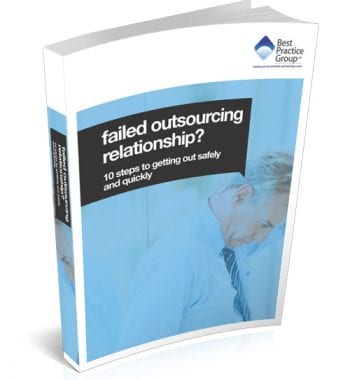 When you recognise that your outsourced/major projects relationship is not performing to expectations, do you go on the charm offensive, crack the whip to bring them back in line, or do you start considering alternative options?
When you recognise that your outsourced/major projects relationship is not performing to expectations, do you go on the charm offensive, crack the whip to bring them back in line, or do you start considering alternative options?
Early termination of complex supplier relationships can be a huge commercial and reputational risk if not undertaken in the right manner. It’s often a significantly greater risk than the original procurement process you undertook, with far-reaching ramifications.
You all know that it is vitally important when considering such an action that you will need to be reliably armed with all the right information. By way of an example, this article looks at the ongoing situation with Northern Rail and what lessons it points to which could help sanity check your own thinking, if you find yourself in a similar situation where you and/or your team perceives terminating the relationship is the only course of action left to you.
Arriva Stripped of their Northern Contract
Just last month it was reported that Northern, the rail franchise operated by Arriva for just under four years, would be brought back under government control. It’s been reported that issues with severe and prolonged cancellations and delays, have dogged the operators for the last few years to the point where it seems the government had no other choice than to step in.
Northern is the UK’s largest train franchise with passenger numbers of around 100 million per year and trains that call at over 500 rail stations. The franchise was supposed to continue for the next five years, but after reviews and warnings from the government throughout the course of last year, the continuation of the status quo was considered to be unacceptable.
The Blame Game
But who is to blame? Transport Secretary, Grant Shapps, said passengers had “lost trust in the north’s rail network” and that “People across the north deserve better”. The people he talks about have reportedly had to suffer over 40% of their trains running late (according to figures from the Office of Rail and Road). However, Northern themselves blame ‘external factors’ such as industrial action by the RMT and issues with rail infrastructure project delays and cancellations.
What Now for Northern?
Reports suggest that many attempts had been made to rectify the situation with Arriva or to involve them in some capacity going forward. It seems, however, that this was not deemed practical.
The government has decided to run the service via an arm’s length company that already runs other train services, rather than completely absorb the service back into the public sector.
Nine Lessons for a Safer, Smoother Exit from your Agreement
Northern Rail’s transition from Arriva to a publicly owned entity is likely to have some challenges during the transition process. While it is reported that there was plenty of evidence of failings in the service, Arriva also point to failures in the rail infrastructure itself which were/are not of their making.
If your organisation perceives it needs to terminate its strategic supplier relationship early, just have on your radar that the termination of any large outsourced/project relationship can be deceptively complex. If it is not handled in the correct way, you’ll often be faced with significant cost and reputational ramifications.
We have itemised nine observations learned from working on hundreds of similar large and mission-critical relationships, to hopefully help sanity check your own thinking in reducing commercial and reputational risks.
Step 1: Sanity check – is termination really the best way forward?
Ask yourself if you have done all that you can to put your relationship back on track? To end something so involved as a strategic supplier relationship is a complex, costly and potentially disrupting exercise. So:
- Do you perceive your supplier has materially failed to deliver on its promises and your expectations (the supplier has been really poor at delivering key aspects of the service and/or project?). If it has and, despite all reasonable efforts from both you and the supplier to help matters get back on track, the evidence is that the service/project has still not achieved your mutual expectations, then the business case for terminating becomes all the stronger.
- Are you sure that you and your client team have not contributed in any material way to the failures you’ve identified in the relationship, by inadvertently preventing the supplier from delivering what it promised?
- Have you followed the escalation process as outlined in your contract? If so, it will allow you to concentrate on discussing the material aspects of the poor service/project delivery with your strategic partner. Otherwise, it is likely you’ll be sidetracked into wasting substantial time and money (legal fees) in arguing with the supplier about the procedural aspects in the contract.
Step 2: Conduct a thorough termination risk assessment
- Identify what a good termination outcome looks like, then assess whether it is realistic to expect this as a result of your actions and with the weight of your evidence.
- Scrutinise your agreement to identify its provisions for termination;, what you are entitled to do; what costs could be incurred as a result; and the practicalities of technology, personnel and premises access throughout the termination process and beyond.
- The financial state of your supplier must also be taken into consideration. Is it worth pursuing them for compensation for breaches or failures to deliver if they have not the means to pay, whether through assets of their own or adequate insurances?
- Are the majority of your stakeholders agreed on your plans for termination, what is the risk to your own and the organisation’s reputation? In legal disputes, the supplier will be advised by its own legal partner to resist the termination. Does the way you have articulated your evidence make it clear to the supplier that termination is the best option for all involved? How will terminating with your current supplier impact on the delivery of your services? How do you know engaging with a different supplier will enable you to deliver on your expectations?
Step 3: How will you achieve a BAU state?
As you know, before you terminate your existing relationship it’s vital to have a clear view of what you will replace it with. Will you simply select another supplier or is it time to bring the service delivery back in-house?
With the additional practical knowledge you have gained in your current relationship, are you able to more clearly identify what good looks like for your service provision? Are you now in a better position to conduct adequate due diligence on a new service provider to deliver on your expectations?
Step 4: The practicalities of exit planning
You’ll know that leaving a strategic relationship is often far trickier than entering it in the first place. Not only will you have considered the potential for success with your new strategic partner, but you also have many other critical factors to consider when exiting the relationship you’re in.
These include what will happen with key staff and the continued provision of services throughout the termination process; whether hard-learned processes have been adequately documented; and how the transfer of intellectual property rights, records and data will be achieved in practical terms. To achieve all of the above and more, it’s vital to appoint a dedicated exit management team who will oversee the transition and deliver on the exit plan.
Step 5: Gathering evidence of failure
Focusing only on the actions which had most material negative impact on your project and relationship, you must gather detailed evidence of your findings, reasoning and costs involved.
- Has your supplier lived up to their ‘expert’ responsibilities? This is their requirement to not only inform you of their capabilities to achieve your outcomes, but to highlight weaknesses in your strategy, how realistic your outcome prospects are and what they are unable to deliver on, as well as the ramifications of this.
- Consider the evidence your supplier may use to counter your claims and to show where they have gone above and beyond in order to drive better outcomes. This will (and should) be used to balance the scales in their favour.
- It’s vital to also consider where your action or inaction could have impacted on the prospects of your project and the nature of your relationship with your supplier. Blame can be, but is rarely, a one-way street. It’s important to shine a light on your own challenges to know what your supplier may counter your claims with.
- What have these failings cost you in terms of time, reputation and money? And, to what degree are you able to independently evidence this?
Step 6: Validate each element of evidence
Once you have gathered all your evidence, check whether a) it appropriately reflects the challenges you have been experiencing, and b) it is likely to stand up to independent scrutiny.
Evidence requires an objective mindset – an extraction of emotions from the process. Do the ‘facts’ really stand up to scrutiny? What are likely to be the legitimate counter arguments? Try to reduce as much subjectivity as you can to determine the degree to which your evidence is structurally sound.
Step 7: What platform and approach for termination will you consider?
There are five primary forums for you to choose from to progress your termination through: informal negotiations, mediation, expert determination, arbitration or litigation. There is no one perfect forum for all situations as each has its strengths and weaknesses. You just need to choose the one that best suits your situation and resources.
Step 8: Conducting your termination discussions
When you commence termination discussions, it’s important not to underestimate the volume of preparation you will need to undertake, in particular, if you are having ‘informal’ (without prejudice) discussions. It takes a lot of time to succinctly articulate evidence so that it is simple for both sides to understand the degree to which it is robust.
It’s also really important to role play between your own teams as to how you will present your evidence. The key rule is that you should know the evidence and likely arguments of the other side better than they do. This way, you’ll know in advance most of their key arguments before you ‘get into the room’. You can be very specific in requesting what evidence they have and how it stands up to scrutiny.
Step 9: Exit means exit
Your exit process, once agreed, must be managed properly. A written agreement needs to be drawn up to ensure that both sides understand their commitments to the exit. It’s vital to keep tabs on milestones to ensure that everything runs according to an agreed schedule. It’s a good idea not to inadvertently undermine your exit strategy by involving the outgoing supplier in new projects – even if time is of the essence to get that project delivered. Keep emotions in check throughout as it’s likely to be a stressful time for both sides.
Conclusion
Coming back to the Northern Rail franchise, Arriva continues to dispute some of the claims the government have laid at their door. Overall, however, they seem to be accepting the early contract termination and apologising for their part in the failings of their service.
Their outward-facing approach seems to indicate that the transition could well be smoother than it could otherwise have been. The government is promising upgrades to the service, rolling stock and infrastructure, but we will have to see whether the government’s intention matches the implementation.
Photo credit: iStock

